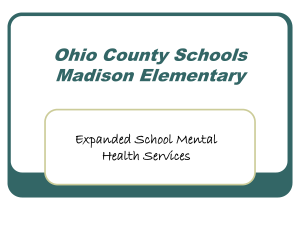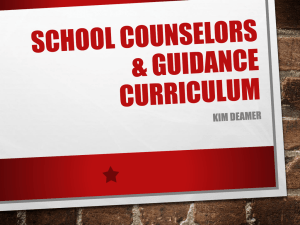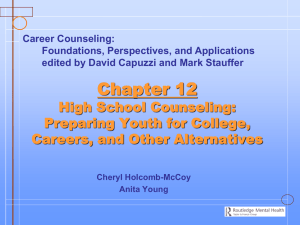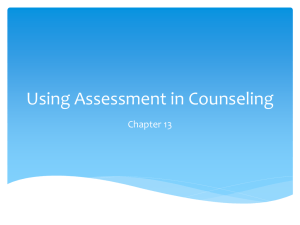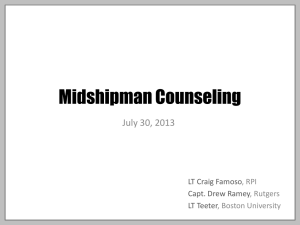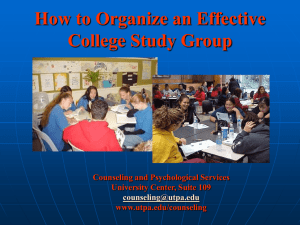A Comprehensive School Counseling Program
advertisement
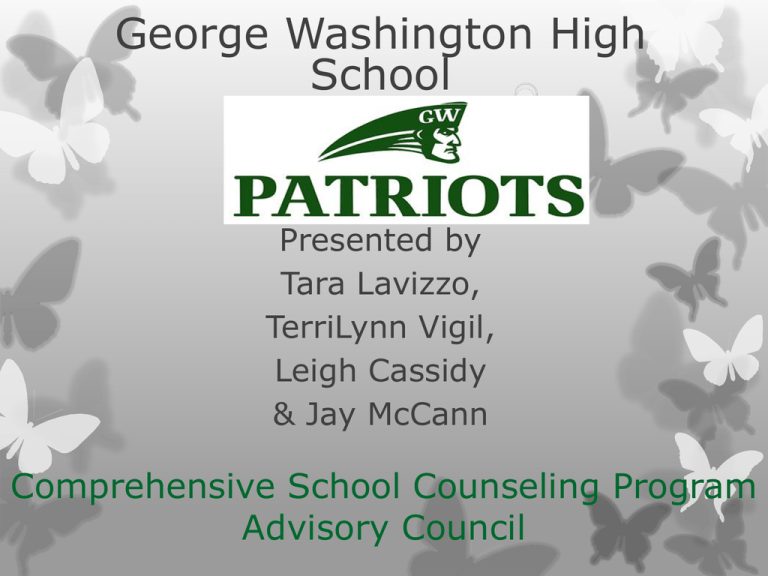
George Washington High School 2013-2014 Presented by Tara Lavizzo, TerriLynn Vigil, Leigh Cassidy & Jay McCann Comprehensive School Counseling Program Advisory Council Yesterday’s Guidance Counselor vs. Today’s School Counselor Guidance Counselor • Reactive • Services to a few • Impact measured via feelings and perception • Ancillary role to school involvement process • School counselors in isolation GSCA Advocacy Committee (2010) Professional School Counselor • Proactive/Data Driven • Services to ALL • Impact measured via achievement data • Essential role in the school improvement process • School counselors as school leaders • Develops, manages, and evaluates a comprehensive school counseling program A Comprehensive School Counseling Program • Addresses academic, career, & personal/social development of all students • Delivers Guidance Curriculum to ALL students • Provides Intentional Guidance for SOME • Utilizes Data • Impacts student performance (Achievement, Behavior, Attendance,) • For GWHS, a 3-5 year action plan that will build capacity and remove barriers • GWHS is one of two high school counseling program in Denver Public Schools to pursue RAMP (Recognized ASCA Model Program) Julie Hartline & Gail Smith (2011) ASCA A Comprehensive School Counseling Program to meet the needs of ALL students PROGRAM FOUNDATION DELIVERY SYSTEM MANAGEMENT ACCOUNTABILITY Julie Hartline (2009) Determines the academic, career, and personal/social needs of the students Addresses the students’ needs via four delivery methods Involves stakeholders and measures the impact of the school counseling program Evaluates the program based on outcomes and makes adjustments School Counseling Pyramid of Intervention Specialized Interventions (Tier 4) Individual Support (Tier 3) Intentional Guidance (Tier 2) Guidance Curriculum (Tier 1) School Improvement Plan Tier 1: Guidance Curriculum “Developmental in design, educational and preventative in nature, and comprehensive in scope, the guidance curriculum ensures that every student in the school will receive services from the guidance program.” Lessons that are delivered to ALL students Lessons on transitioning to high school Lessons on academic planning Lessons on goal setting Lessons on career awareness Standards based (ASCA) Dimmitt, Carey, & Hatch (2007) Julie Hartline & Gail Smith (2011) Tier 2: Intentional Guidance Academic, career, or personal/social interventions are provided to SOME students SOME students need more Small Group Counseling Group Guidance Activities Motivation Groups Academic Groups Group for seniors without a future plan Brown Bags for seniors Julie Hartline & Gail Smith (2011) Tier 3: Individual Support Can Include: Individual student planning (appraisal or advisement) Consultation with parents, teachers, and community organizations Individual counseling Crisis Counseling/Response Referrals to outside agencies or SSW Peer Facilitation (mediation, conflict resolution, mentors, tutors, peer support programs) Julie Hartline & Gail Smith (2011) Tier 4: Specialized Interventions (Coordinated by Mental Health Team) Agency Referral Emergency Crisis treatment Family Preservation Hospitalization Probation/Incarceration Disabilities Programs Long-Term Therapy Julie Hartline & Gail Smith (2011) Counseling Program Goals for 2013-2014 Goal #1- To decrease the achievement gap by increasing academically-focused interventions Goal #2- To increase college-readiness for all students by offering post-secondary preparation Goal #3- To increase visibility, distribution and communication of resources to all stakeholders in order to provide equal access to college-readiness within the school Goal #1- To decrease the achievement gap by increasing academically-focused interventions Create Student Intervention Team Decrease the number of students on the D and F list. Improve students’ attitudes, skills and knowledge with regard to study skills, stress and motivation Goal #2- To increase college-readiness for all students by offering post-secondary preparation 90% of each 9th, 10th and 11th grade class will complete Personal Educational Plans (PEPs) through Naviance. Increase amount of students taking the Accuplacer to broaden remediation classes offered at high school Welcome to High School presentations Pathways to Your Future workshop ACT prep Incoming Freshmen Night AP Showcase Night Goal #3- To increase visibility, distribution and communication of resources to all stakeholders in order to provide equal access to college-readiness within the school Technological resources Website Electronic bulletin board Newsletter/Calendar Showing Data and RAMP process Schedule change process School-wide programs (during school) Choice of Studies presentations College Fair Electives Fair Evening programs FAFSA, Financial Aid, Admissions, Back to School Night, Incoming 9th graders, Junior meeting, ACT Prep, Essay Writing, NCAA Clearinghouse Barriers to achieving goals Coordination and administration duties Pre-collegiate scheduling, invitations, follow up, interviews, etc Setting up all classroom presentations/ meetings, College Readiness Day access to computers, computer labs/community room and students for PEPs/Classroom guidance, rescheduling PEPs when teachers don't come Unreasonable amounts of emails Getting students signed up for Accuplacer, marketing Accuplacer, Accuplacer paperwork 4 year course plans on PEPs Barriers to achieving goals Course and schedule changes Inputting all course requests for the following year- data entry in IC Student requested schedule changes for over 2 weeks, angry parents regarding schedules, Administrative requested schedule changes for classes created after school starts Compiling course descriptions (for due diligence regarding what each class is) Building schedules for students who do not turn in Choice of Studies Form Cleaning up the master schedule at the end of school year (getting them out to students earlier) Enrolling new students Deciphering new student transcripts Concurrent Enrollment Balarat- help sign up; monitor; rescheduling; check attendance; update grades RIB schedule changes Barriers to achieving goals Data entry and clerical ACT Pre-enrollment bubbling and follow up with those that didn’t come Uploading every single transcript sent to colleges to Naviance (initial, mid-year, and end of year) Letter of rec submissions/transcript submissions OTG report Scheduling 504 meetings PSAT Registration and sign ups Handing out papers/ schedules at Parent-Teacher Conferences AP test proctoring Accuplacer test proctoring Summer school registration Needs Assessment Results The GWHS School Counseling Department conducted a needs assessment during the 2013-2014 school year. Below is a brief summary of the data collected. I feel sad. – 4.3%- All the time - 26.1%- Some of the time I feel angry. – 5.6%- All the time -28.8%- Some of the time I feel comfortable talking to my teachers: a. Strongly agree 20.9% (90) b. Agree 54.4% (234) c. Disagree 19.3% (83) d. Strongly disagree 5.3% (23) TOTAL RESPONSES 100% (430) Needs Assessment Results What will be the biggest barrier to you going to college? Students want more help in the following areas: 51.5% said Cost/No Financial Aid • Study Skills - 65.6% • ACT Prep - 50.1% 30.2% said Grades • Anxiety/Stress - 40.7% • Involvement in School Act. 36.9% • Organizational Skills - 27.9% • Catching up on Credits - 27.6% • Self-esteem - 20.7% 25.4% of all students have never visited a college? 87.1% of students would be willing to pay $10 for transportation Action Plan for next year How we see students needing our help as a program According to ASCA’s best practices, and based on our student need assessment data, the school counseling department at GWHS would like to focus their work towards: Intentional guidance for social/emotional concerns College awareness and financial planning Intentional guidance around building academic skills Improving tutoring ACT Preparation Academic support groups and/or classes Reflection & Feedback How can the Advisory Council help guide the work of School Counseling Department at GWHS? Are there additional areas of need/support that have not yet been identified? Questions??? Thank You!! Now our department is ready to RAMP up!


